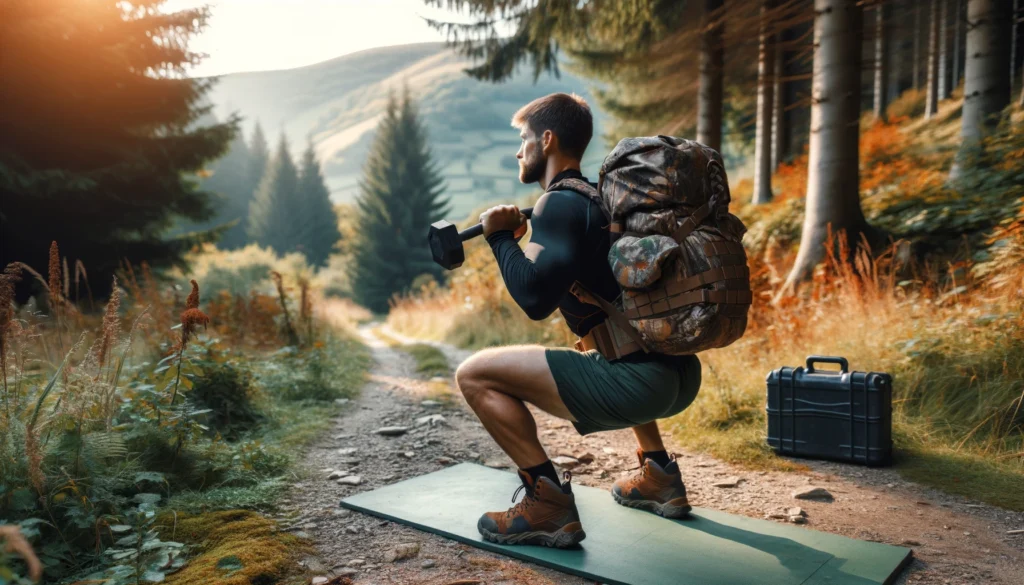Physical Fitness for Hunting: Preparing Your Body for the Wilderness

Table of Contents
- Introduction
- 1. Understanding the Physical Demands of Hunting
- 2. Essential Exercises for Hunters
- 3. Practical Fitness Routines
- 4. Nutrition for Hunters
- 5. Mental Preparation
- 6. Safety Considerations
- 7. Tracking Progress and Adjusting Plans
- 8. Adaptations for Different Types of Hunting
- 9. Seasonal Adjustments
- 10. Practical Tips for Maintaining Fitness During Hunting Season
- 11. Engaging with the Hunting Community
- Conclusion
- Frequently Asked Questions (FAQs)
- How long before hunting season should I start training?
- Can older adults or those with physical limitations still enjoy hunting?
- How can I prevent injuries while training for hunting?
- What should I do if I encounter an injury during the hunting season?
- How can I maintain my fitness if I can’t access a gym?
- Is it important to involve children in physical fitness for hunting?
Introduction
Hunting is a physically demanding activity that requires strength, endurance, and agility. Being physically fit enhances your hunting experience by improving your performance, safety, and overall enjoyment. This guide will provide a comprehensive approach to developing the physical fitness needed for hunting, including exercises, nutrition, and practical tips.
1. Understanding the Physical Demands of Hunting
- Uneven Ground: Hunting often involves traversing uneven and challenging terrain, requiring strong legs and good balance.
- Carrying Gear: Hunters need to carry gear, weapons, and sometimes the game itself, demanding upper body strength and stamina.
1.2 Weather Conditions
- Adverse Weather: Hunting in various weather conditions requires a resilient body capable of maintaining performance in cold, heat, or wet conditions.
1.3 Extended Periods of Activity
- Endurance: Hunts can last for several hours or even days, necessitating sustained physical and mental endurance.
2. Essential Exercises for Hunters
2.1 Cardiovascular Fitness
- Running and Hiking: Engage in regular running or hiking to build cardiovascular endurance. Aim for at least 30 minutes of moderate to vigorous activity, 3-4 times a week.
- Interval Training: Incorporate interval training to enhance stamina and improve recovery times between bursts of intense activity.
2.2 Strength Training
- Leg Strength: Focus on exercises like squats, lunges, and step-ups to strengthen the legs and improve stability.
- Upper Body Strength: Perform push-ups, pull-ups, and rows to build the upper body strength necessary for carrying gear and handling weapons.
- Core Stability: Strengthen your core with planks, sit-ups, and rotational exercises to improve balance and reduce the risk of injury.
2.3 Flexibility and Mobility
- Stretching: Incorporate daily stretching routines to enhance flexibility and prevent injuries.
- Yoga: Practice yoga to improve overall body flexibility, balance, and mental focus.
3. Practical Fitness Routines
3.1 Sample Weekly Workout Plan
- Monday: 30-minute run followed by upper body strength training (push-ups, pull-ups, rows).
- Tuesday: Hiking with a weighted pack, focusing on leg strength and endurance.
- Wednesday: Rest or light activity such as walking or yoga.
- Thursday: Interval training (running sprints) and core exercises (planks, sit-ups).
- Friday: Full-body strength training, including squats, lunges, and step-ups.
- Saturday: Outdoor activity such as hiking or a long run.
- Sunday: Rest and recovery, including stretching and foam rolling.
4. Nutrition for Hunters
4.1 Balanced Diet
- Macronutrients: Ensure a balanced intake of carbohydrates, proteins, and fats to fuel your body for intense physical activity.
- Hydration: Stay well-hydrated, especially during long hunts. Carry enough water and electrolyte-replenishing drinks.
4.2 Pre-Hunt Nutrition
- Energy-Rich Foods: Consume complex carbohydrates and lean proteins before a hunt to maintain energy levels.
4.3 During the Hunt
- Snacks and Meals: Carry high-energy snacks like nuts, dried fruits, and energy bars. Plan for meals that are easy to prepare and provide sustained energy.
5. Mental Preparation
5.1 Focus and Concentration
- Mindfulness and Meditation: Practice mindfulness and meditation to improve mental clarity and focus during hunts.
5.2 Stress Management
- Relaxation Techniques: Use deep breathing exercises and other relaxation techniques to manage stress and maintain composure in challenging situations.
6. Safety Considerations
6.1 Injury Prevention
- Warm-Up and Cool-Down: Always warm up before physical activity and cool down afterward to prevent injuries.
- Proper Technique: Use proper techniques for lifting and carrying heavy loads to avoid strains and sprains.
6.2 First Aid Knowledge
- Emergency Preparedness: Carry a first aid kit and know basic first aid procedures to handle injuries that may occur in the field.
7. Tracking Progress and Adjusting Plans
7.1 Setting Goals
- Short and Long-Term Goals: Set realistic fitness goals and track your progress. Adjust your fitness plan as needed to meet these goals.
7.2 Regular Assessments
- Physical Assessments: Regularly assess your physical fitness levels through timed runs, strength tests, and flexibility measurements to ensure you are on track.
8. Adaptations for Different Types of Hunting
8.1 Bowhunting
- Upper Body Strength: Bowhunting requires significant upper body strength and endurance. Focus on exercises like resistance band pulls, shoulder presses, and rows.
- Stability and Precision: Enhance stability and precision with core-strengthening exercises and balance training, such as standing on one leg or using a balance board.
8.2 Rifle Hunting
- Steady Aim: Develop a steady aim through exercises that strengthen your arms, shoulders, and core. Practice holding weights at arm’s length to simulate holding a rifle.
- Cardiovascular Endurance: Long treks in rugged terrain are common in rifle hunting, so prioritize cardiovascular exercises such as hiking, running, and interval training.
8.3 Waterfowl Hunting
- Quick Movements: Improve agility and reaction time with plyometric exercises and agility drills.
- Cold Weather Preparedness: Train in cold conditions when possible to acclimate your body to the challenges of waterfowl hunting environments.
8.4 Big Game Hunting
- Endurance and Strength: Big game hunting often involves long hikes with heavy packs. Combine cardiovascular endurance training with strength training focused on your legs, back, and core.
- Flexibility: Maintain flexibility with regular stretching and yoga to handle the varied terrain and movements required.
9. Seasonal Adjustments
9.1 Off-Season Training
- Building a Base: Use the off-season to build a strong fitness base. Focus on overall strength, endurance, and flexibility.
- Skill Practice: Continue practicing hunting skills, such as shooting, tracking, and navigation, to keep your abilities sharp.
9.2 Pre-Season Ramp-Up
- Intensifying Workouts: Gradually increase the intensity and frequency of your workouts as the hunting season approaches.
- Simulation Exercises: Engage in activities that simulate hunting conditions, such as carrying a weighted pack on hikes or practicing shooting after physical exertion.
10. Practical Tips for Maintaining Fitness During Hunting Season
10.1 Short, Effective Workouts
- Time Management: During hunting season, time may be limited. Focus on short, high-intensity workouts to maintain fitness without taking too much time away from hunting.
10.2 Active Recovery
- Stay Active: Use rest days for active recovery activities such as light hiking, stretching, or yoga to keep your body moving and reduce soreness.
10.3 Nutrition and Hydration on the Go
- Healthy Snacks: Pack nutritious snacks like protein bars, nuts, and dried fruit to keep your energy levels up during long hunts.
- Hydration: Stay hydrated by carrying enough water and electrolyte-replenishing drinks, especially during physically demanding hunts.
11. Engaging with the Hunting Community
11.1 Group Workouts
- Motivation: Join group workouts with fellow hunters to stay motivated and share fitness tips.
- Accountability: Working out with a group can provide accountability and make training more enjoyable.
11.2 Learning from Experienced Hunters
- Mentorship: Seek advice from experienced hunters on how they maintain their fitness and prepare for the season.
- Community Events: Participate in community events and hunting expos to learn about new fitness techniques and gear.
Conclusion
Physical fitness is a crucial component of successful and enjoyable hunting. By following a structured fitness plan, maintaining a balanced diet, and preparing mentally, you can enhance your performance in the field and ensure your safety. Embrace the physical demands of hunting as an opportunity to improve your overall health and well-being.
Frequently Asked Questions (FAQs)
How long before hunting season should I start training?
- Preparation Time: Ideally, start your fitness training at least 3-6 months before the hunting season to ensure you are adequately prepared.
Can older adults or those with physical limitations still enjoy hunting?
- Adapted Plans: Yes, hunting can be enjoyed by people of all ages and abilities. Tailor your fitness plan to your specific needs and capabilities, and consider less physically demanding hunting methods if necessary.
How can I prevent injuries while training for hunting?
- Injury Prevention: Always warm up before workouts and cool down afterward. Focus on proper form and technique during exercises. Gradually increase intensity and volume to avoid overuse injuries.
What should I do if I encounter an injury during the hunting season?
- Handling Injuries: If you sustain an injury, rest and seek medical attention if necessary. Engage in low-impact activities that do not exacerbate the injury, and focus on recovery exercises recommended by a healthcare professional.
How can I maintain my fitness if I can’t access a gym?
- Home Workouts: Utilize bodyweight exercises, resistance bands, and household items for strength training. Engage in outdoor activities like hiking, running, and climbing to build cardiovascular endurance.
Is it important to involve children in physical fitness for hunting?
- Youth Fitness: Introducing children to physical fitness for hunting can instill healthy habits and prepare them for future hunting activities. Focus on fun, age-appropriate exercises and activities that develop strength, coordination, and endurance.







